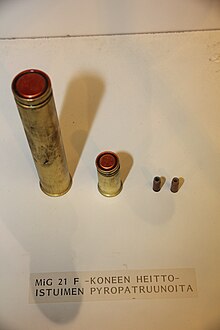Asquibis a miniatureexplosivedevice used in a wide range of industries, fromspecial effectstomilitaryapplications. It resembles a tiny stick ofdynamite,both in appearance and construction, but has considerably less explosive power. A squib consists of two electrical leads separated by a plug of insulating material; a smallbridge wireor electrical resistance heater; and a bead of heat-sensitive chemical composition, in which the bridge wire is embedded.[1]They can be used to generate mechanicalforceto shatter or propel various materials; and forpyrotechniceffects forfilmand livetheatrics.[2]




A squib generally consists of a small tube filled with an explosive substance, with adetonatorrunning through the length of its core, similar to a stick of dynamite. Also similar to dynamite, the detonator can be a slow-burningfuse,or as is more common today, awireconnected to a remoteelectronictrigger.[3]Squibs range in size from ~2 to 15 mm (0.08 to 0.6 in) in diameter.[2]
Film industry
editIn the film industry, the termsquiboften refers toelectric matchesanddetonatorsused to trigger larger pyrotechnics. They are generally (but not always) the main explosive element in an effect, and are often used inspecial effectsto simulate bullet impacts on inanimate objects or actors.[4]Fake bloodpackets are typically coupled with squibs and attached to thestage clothesworn by actors, referred to asdead-character costumes,that burst through pre-made "bullet" holes to simulate the appearance of a person being shot and wounded. This creates a realistic and convincing visual effect for movies, TV shows, and stage performances.
Automotive industry
editSquibs are used inemergencymechanisms wheregas pressureneeds to be generated quickly in confined spaces, while not harming any surrounding persons or mechanical parts. In this form, squibs may be calledgas generators.Two such mechanisms are the inflation ofautomobileair bagsandseat belt pretensionerswhich sometimes use pyrotechnic devices.
Pyro fuses are also used to disconnect the vehicle's power circuit. The pyro fuse is installed on the positive terminal of the battery and receives a signal from the vehicle's control unit in the event of an accident. During an accident, the pyrotechnic charge in the pyrofuse is triggered, which uses a piston to break the power circuit and de-energize the vehicle's battery.[5]
In 2003, the European Commission adopted Directive 2000/53/EC[6]on end-of-life vehicles (ELV Directive). This measure was introduced to prevent potential fires that may occur due to battery damage during an accident. Battery pyro-fuses ensure instant power disconnection, minimizing the risk of short circuits and fires
Aerospace industry
editInmilitary aircraft,squibs are used to deploycountermeasuresand are also implemented during ejection to propel thecanopyandejection seataway from a crippled aircraft. They are also used to deployparachutes.[3]
Other uses
editSquibs are also used in automaticfire extinguishers,to pierce seals that retain liquids such ashalon,fluorocarbon,orliquid nitrogen.
History
editSquibs were originally made fromparchmenttubes, or the shaft of afeather,and filled with fineblack powder.They were then sealed at the ends with wax. They were sometimes used to ignite the main propellant charge in acannon.[7]
Squibs were once used incoal miningto break coal away fromrock.In the 1870s, some versions of the device were patented and mass-produced as "Miners' Safety Squibs".[8]
The famous "Squib Case"
editSquibs are mentioned in the prominenttortcase from eighteenth-century England,Scott v. Shepherd,96 Eng. Rep. 525 (K.B. 1773). A lit squib was thrown into a crowded market by Shepherd and landed on the table of a gingerbread merchant. A bystander, to protect himself and the gingerbread, threw the squib across the market, where it landed in the goods of another merchant. The merchant grabbed the squib and tossed it away, accidentally hitting a man in the face, putting out one of his eyes.
Squibs in films
editThe first documented use of squibs to simulate bullet impacts in cinema was in the 1943 US war filmBataan.[9]
Other early films using squibs include the 1955 Polish filmPokoleniebyAndrzej Wajda,where for the first time audiences were presented with a realistic representation of a bullet impacting on an on-camera human being, complete with blood spatter. The creator of the effect,Kazimierz Kutz,used acondomwith fake blood and dynamite.[10]
However, the Americanwestern,River of No Return,filmed in 1953 and released in 1954, used a blood squib to simulate realistic bullet impact in the story's climax, when the story's antagonist is shot dead[citation needed].As such, this film precedesRun of the Arrow(1957) – often credited with being the first to use blood squibs – by three years, andPokolenieby one.
Origin of the phrase "damp squib"
edit
While most modern squibs used by professionals are insulated from moisture, older uninsulated squibs needed to be kept dry in order to ignite, thus a "damp squib" was literally one that failed to perform because it got wet. Oftenmisheardas "damp squid",[11]the phrase "damp squib" has since come into general use to mean anything that fails to meet expectations.[12]The word "squib" has come to take on a similar meaning even when used alone, as a diminutive comparison to a full explosive.[13]
See also
editReferences
edit- ^Thibodaux, J. G. (July 1, 1961)."Special Rockets and Pyrotechnics Problems".Langley Research Center.NTRS.Retrieved20 May2019.
- ^ab"Top 10 Frequently Asked Questions".Fantasy Creations FX.Archived fromthe originalon 10 July 2011.
- ^abUS 5411225,Lannon, Robert G. & Weldon, William F., "Reusable non-pyrotechnic countermeasure dispenser cartridge for aircraft", published 1995-05-02
- ^Fantasy Creations FX."Top 10 Frequently Asked Questions".
- ^"Пиропатрон АКБ или аварийный размыкатель цепи АКБ | Новости".hodovik.com.Retrieved2024-07-05.
- ^Directive 2003/87/EC of the European Parliament and of the Council of 13 October 2003 establishing a scheme for greenhouse gas emission allowance trading within the Community and amending Council Directive 96/61/EC (Text with EEA relevance),vol. 275, 2003-10-13,retrieved2024-07-05
- ^Calvert, James B."Cannons and Gunpowder".University of Denver.Archived fromthe originalon 2007-07-01.
- ^Wallace, Anthony F. C. (1988).St. Clair, a nineteenth-century coal town's experience with a disaster-prone industry.Cornell University Press. p. 50.ISBN978-0-8014-9900-5.
- ^Bender, Stuart Marshall (2014-01-01)."Blood Splats and Bodily Collapse: Reported Realism and the Perception of Violence in Combat Films and Video Games".Projections.8(2): 1–25.doi:10.3167/proj.2014.080202.hdl:20.500.11937/3029.ISSN1934-9688.
- ^"Pokolenie".Gazeta Wyborcza.2008. Archived fromthe originalon 2012-06-03.
- ^"Damp Squid: The top 10 misquoted phrases in Britain".The Daily Telegraph.London. 24 February 2009.
- ^"Definition of damp squib".Allwords.com.
- ^"squib: Definitions, Synonyms".Answers.com.